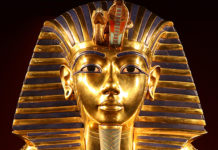Miraculously unplundered, the Anglo-Saxon ship burial discovered at Sutton Hoo in1939 throws light on a mysterious time in English history.
Discovered in the summer of 1939, just as war was looming, the Sutton Hoo ship housed the most richly furnished burial chamber found on British soil. Its gold and silver, helmet and sword, drinking horns and lyre are a throwback to an age of warrior kings and pagan gods. It’s hard to think of the Sutton Hoo burial ship and all its treasures and not think of the epic poem Beowulf.
The Sutton Hoo Ship Burial
The Sutton Hoo burial ground, on an escarpment overlooking the River Deben in Suffolk, dates to the late sixth/early seventh century. The discovery of the Sutton Hoo ship was made by local archaeologist Basil Brown, who had been hired by landowner Mrs Edith Pretty. Miraculously, the burial chamber in the centre had escaped being plundered by treasure-seekers. The archaeologists, including experts brought in from the British Museum, were astonished by the scope of what they found.
Archaeological Finds From Sutton Hoo
The 263 finds from Sutton Hoo were recovered as fragments, broken when the timber burial chamber collapsed under the weight of the mound. Reconstruction was a long and painstaking task.
The finds are high status objects, clearly denoting the burial of an important individual, most likely a king. As befits a warrior king, many of the finds are from the world of battle. There is a large parade shield, an iron helmet (which has become something of a symbol of Sutton Hoo) and, most tellingly, a pattern-welded sword. In the Anglo-Saxon world, swords were at the pinnacle of the hierarchy of weaponry.
Other finds appear to be symbols of office. Archaeologists found a large iron stand, reminiscent of a Roman standard, and a whetstone topped by a bronze stag with magnificent antlers which has been described as a sceptre.
Also found was a purse containing 37 gold coins, three unstamped coin-sized discs and two gold ingots. The coins were all minted in Merovingian Gaul (present-day France) although no two came from the same mint. The Sutton Hoo ship had 40 rowers, and Professor Philip Grierson has suggested that the coins and ingots were there to pay the rowers, pilot and steersman to row the ship to the afterlife.
The finds also show how connected Anglo-Saxon East Anglia was to the rest of the known world. The artefacts recovered from the Sutton Hoo burial ship came from Scandinavia, France, Italy and the Eastern Mediterranean, as well as from more local centres.
Who Was Buried in the Sutton Hoo Ship Burial?
There’s no doubt that the Sutton Hoo ship burial is the final resting place of a powerful individual. The sheer size of the ship, and the abundance of high status grave goods make that clear. It is hard to say for certain, given the lack of an inscription, who was buried there, but the scholarly consensus is that it was the burial place of King Raedwald, described by the Venerable Bede as holding “sway over all the provinces south of the Humber.” Raedwald died in about 625, so the date is about right.
After three excavations – in 1938/39, 1965/71 and 1986/92 – the Sutton Hoo burial ground continues to fascinate. Artefacts from the burial ship can be seen in the Medieval Room at the British Museum. Sutton Hoo, near Woodbridge in Suffolk, is also open to visitors. Administered by the National Trust, the estate is open from 10.30am to 5pm in the summer, and from 11am to 4pm in the winter.








